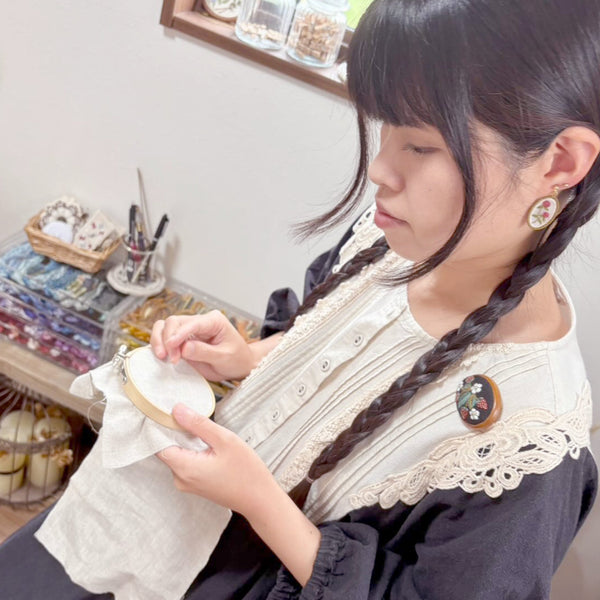Fusion of Traditional Japanese Craftsmanship and Modern Handmade Art: The Versatile Mino Ware

Mino ware's evolution reflects people's changing preferences and trends. Artisans constantly innovate their techniques and values to create ceramics that meet the demands of the times.
Japanese handmade jewelry artists, such as Lina Accessory and Hokulea, leverage the unique qualities of Mino ware—lightweight, durable, and versatile—to transform what was traditionally used as tableware or wall tiles into distinctive wearable accessories. By blending the millennia-old Japanese craftsmanship with modern design, they deliver unique pieces to you and me.
Mino ware is a type of ceramics made in regions such as Tajimi, Toki, Kani, Mizunami, and Kasahara in Gifu Prefecture, all renowned for their ceramic production.
Most Mino ware is produced using techniques like throwing, hand-building, and molding. After forming, the pieces are typically painted or carved, then bisque-fired. Following the bisque firing, various glazes are applied before the final high-temperature firing.
Glazes: Enhancing Beauty, Durability, and Waterproofing
Glazes are coating materials applied to the surface of ceramics. Their main functions are to enhance the ceramic's aesthetic appeal, durability, and waterproofing. A glaze is a liquid glass that is usually applied during the firing process and melts at high temperatures to form a smooth surface. Depending on the type, the effects, color softness, and texture of the glaze can vary.
The colors of Mino ware are determined by the glazes used:
- Green: Oribe glaze contains a lot of iron and appears green after firing. It is famous in Oribe ware.
- White: Shino glaze is a transparent white glaze used in Shino ware, known for its soft and warm white color.
- Yellow: Kiseto glaze contains iron and shows a bright yellow color when fired, used in Kiseto ware.
- Amber: Ameyu is a type of iron glaze that shows a yellow-brown, amber color when oxidized and fired.
- Black: Seto Black glaze appears deep black and is used in Seto Black ware. Tenmoku glaze forms a deep black under high-temperature firing and is common in Tenmoku tea bowls.
- Blue-Green: Celadon glaze, resulting from the reaction of iron and copper, creates a beautiful blue-green color used in celadon ware.
- Brown: Iron glaze, with a high iron content, shows deep brown or black colors, characterized by its calm and composed style.
- Transparent Colors: Ash glaze, made from wood ash or straw ash, produces natural transparency and soft tones.
These glazes, through different components and firing conditions, showcase the diverse colors and textures of Mino ware.
Unique Creations by Lina Accessory and Hokulea
Lina accessory uses the transparent ash glaze, amber glaze, and dark brown iron glaze to create earrings. She adds exclusive patterns using watercolors and oil paints on the naturally fired Mino ware colors.
Hokulea preserves the original hues and patterns of Mino ware tiles, incorporating various materials and shapes to create simple yet unique earrings, necklaces, and rings.
The same Mino ware reveals a multitude of possibilities through these transformations.
At hōbi, we together, Japanese handmade artists continue to carry forward the beauty of this thousand-year-old craft.
(End)
*興味をお持ちの方は、以下の翻訳文を参考にしていただければ幸いです。*
日本の伝統工芸と現代手作りの融合 - 多様性に富んだ美濃焼
美濃焼の進化から、人々の好みや流行の傾向が見えてきます。職人たちは常に技術と価値観を革新し、時代のニーズに応じた陶器を作り出しています。
日本の手作り作家であるLina accessoryとHokuleaも、美濃焼の特徴を活かしています。軽量で堅牢、そして多様性に富んだ美濃焼の陶器を、かつては食器や壁タイルとして使われていたものを、作家が独自の特徴を持つ身に着けるアクセサリーへと変貌させています。千年を超える日本の伝統工芸と現代デザインが融合し、唯一無二の作品が私達の手に届くのです。
美濃焼は、岐阜県の多治見、土岐、可児、瑞浪、笠原などの地域で製作されている陶器です。これらの地域は、陶器の名産地として知られています。
ほとんどの美濃焼は「ろくろ成形、手びねり、型押し」などの技法で生産されます。成形後、通常は絵付けや彫刻が施され、素焼きが行われます。素焼き後、さまざまな釉薬を使用して釉掛け(上釉)し、最後に本焼きを行います。釉薬とは、陶器の表面に塗布される材料で、主に陶器の美観、耐久性、防水性を高める役割を果たします。液体ガラスのようなもので、陶器の焼成過程で施され、高温で溶けて滑らかな表面を形成します。釉薬の種類によって、効果、色合いの柔らかさ、質感などが異なります。
美濃焼の色合いは使用する釉薬によって決まります:
- 緑色
- 織部釉薬:鉄分が多く含まれ、焼成後に緑色になります。織部焼きはこの釉薬で有名です。
- 白色
- 志野釉薬:透明感のある白色釉薬で、志野焼きに使用されます。柔らかく温かみのある白色が特徴です。
- 黄色
- 黄瀬戸釉薬:鉄分を含む黄色釉薬で、焼成時に鮮やかな黄色を示します。黄瀬戸焼きで使用されます。
- 飴釉:鉄釉の一種で、酸化焼成により黄褐色や飴色を呈します。
- 黒色
- 瀬戸黒釉薬:深い黒色の釉薬で、瀬戸黒焼きに使用されます。
- 天目釉薬:高温焼成で深い黒色を形成し、天目茶碗でよく見られます。
- 青緑色
- 青磁釉薬:鉄と銅の反応で美しい青緑色を生成し、青磁焼きに使用されます。
- 茶色
- 鉄釉:大量の鉄分を含み、深い茶色や黒色を呈します。落ち着きのあるスタイルが特徴です。
- 透明感のある色
- 灰釉:木灰や稲藁灰を原料に使い、自然な透明感と柔らかい色調を生み出します。
これらの釉薬は異なる成分と焼成条件によって、美濃焼の多様な色合いや質感を展現します。
lina accessoryは、透明感のある灰釉、黄褐色の飴釉、深い茶色の鉄釉を使用して耳飾りを作り、自然な美濃焼の色合いの上に水彩や油彩で専用のデザインを施しています。
Hokuleaは、美濃焼のタイルの元々の色合いや模様を保持し、さまざまな素材や形状のパーツを使ってシンプルで個性的な耳飾りやネックレス、指輪などのアクセサリーを作り出しています。
同じ美濃焼でも、多くの可能性が広がっています。
hōbi と日本の手作り作家たちが一緒に、この千年の工芸の美を引き継いでいます。








